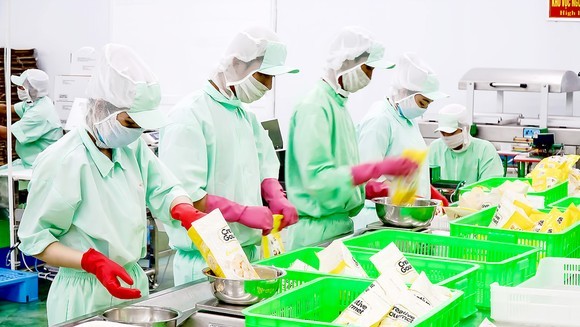 Illustrative image (Photo: SGGP)
Illustrative image (Photo: SGGP)
Hung noted that amid Covid-19 impacts and the interruption of global supply chains, trade between Vietnam and the US has still grown. In the first nine months of this year, two-way trade rose 20 percent year on year to US$96.2 billion, including $85.1 billion worth of Vietnam’s exports, accounting for 30 percent of the Southeast Asian country's total export revenue in the period.
The US is currently the largest export market of Vietnam, while Vietnam is the fifth largest trade partner of the US, accounting for about 4 percent of the US's total import turnover.
The Ministry of Industry and Trade said t if the growth rate in the last nine months is maintained, Vietnam's import-export turnover may reach over $740 billion in 2022.
Hung said that Vietnam’s advantages in the US include the enhancement of the Vietnam-US comprehensive partnership and visits by senior leaders of the two nations, which have laid firm foundation for bilateral economic and trade ties.
At the same time, the effective implementation of the Vietnam-US Trade and Investment Framework Agreement (TIFA) has helped deal with many tough problems in economic and trade relations.
In addition, the trade and geopolitical conflicts as well as the inflation situation will help Vietnamese goods increase their market shares, occupying the vacancy of Russian and Chinese products in the US. In the current context, the trend of shifting supply chains has given Vietnam opportunities to expand production activities and participate more deeply in the global value chains, Hung stated.
However, he stressed that these favorable factors are only momentary, while legal and technical barriers to trade are also significant difficulties for Vietnamese enterprises in the US market.
In order to make full use of the advantages and opportunities and develop sustainably, enterprises must actively enhance their competitiveness and improve technologies as well as labor productivity, while actively joining regional and global production and supply chains, and fully enforcing regulations of US authorities, avoid violating regulations on investment, labor, environment and goods origin, he advised.
He said that the Vietnam Trade Office in the US will continue to work hard to protect the interests of Vietnamese businesses and remove difficulties facing exporting activities, while continuing to coordinate with the US side in anti-dumping issues.
Meanwhile, the office will focus on updating domestic firms about the US's policies, providing information about the US market's demands, connecting investment partnership in industry, seeking more material supply sources for domestic production, and attracting more investment in stages of production and supply of materials and equipment for the development of the energy industry, especially renewable energy, he said.
Hung said that in the coming time, the office will coordinate with relevant agencies to organize a Vietnam-US trade forum in Ho Chi Minh City in November. It will join hands with the Vietnam Chamber of Commerce and Industry (VCCI) to arrange a trip for about 40 businesses to explore opportunities in the US market in later November, he added.
The US is currently the largest export market of Vietnam, while Vietnam is the fifth largest trade partner of the US, accounting for about 4 percent of the US's total import turnover.
The Ministry of Industry and Trade said t if the growth rate in the last nine months is maintained, Vietnam's import-export turnover may reach over $740 billion in 2022.
Hung said that Vietnam’s advantages in the US include the enhancement of the Vietnam-US comprehensive partnership and visits by senior leaders of the two nations, which have laid firm foundation for bilateral economic and trade ties.
At the same time, the effective implementation of the Vietnam-US Trade and Investment Framework Agreement (TIFA) has helped deal with many tough problems in economic and trade relations.
In addition, the trade and geopolitical conflicts as well as the inflation situation will help Vietnamese goods increase their market shares, occupying the vacancy of Russian and Chinese products in the US. In the current context, the trend of shifting supply chains has given Vietnam opportunities to expand production activities and participate more deeply in the global value chains, Hung stated.
However, he stressed that these favorable factors are only momentary, while legal and technical barriers to trade are also significant difficulties for Vietnamese enterprises in the US market.
In order to make full use of the advantages and opportunities and develop sustainably, enterprises must actively enhance their competitiveness and improve technologies as well as labor productivity, while actively joining regional and global production and supply chains, and fully enforcing regulations of US authorities, avoid violating regulations on investment, labor, environment and goods origin, he advised.
He said that the Vietnam Trade Office in the US will continue to work hard to protect the interests of Vietnamese businesses and remove difficulties facing exporting activities, while continuing to coordinate with the US side in anti-dumping issues.
Meanwhile, the office will focus on updating domestic firms about the US's policies, providing information about the US market's demands, connecting investment partnership in industry, seeking more material supply sources for domestic production, and attracting more investment in stages of production and supply of materials and equipment for the development of the energy industry, especially renewable energy, he said.
Hung said that in the coming time, the office will coordinate with relevant agencies to organize a Vietnam-US trade forum in Ho Chi Minh City in November. It will join hands with the Vietnam Chamber of Commerce and Industry (VCCI) to arrange a trip for about 40 businesses to explore opportunities in the US market in later November, he added.
























